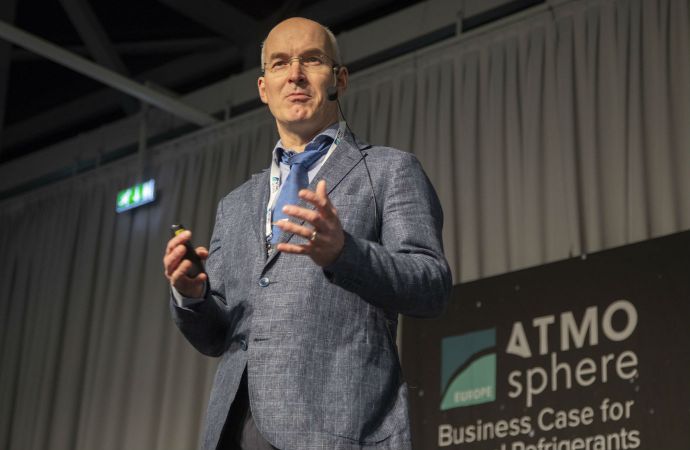Air-conditioning and heat pump applications are promising growth markets for natural refrigerants, heard ATMOsphere Europe conference participants today.

Professor Armin Hafner from the the Norwegian University of Science and Technology (NTNU) addresses ATMOsphere Europe at Lago di Garda today.
Air-conditioning and heat pump applications are promising markets for natural refrigerant growth, heard participants in the ATMOsphere Europe conference in Italy today.
“Heat pumps are a perfect application for CO2, especially to produce hot water, due to the large temperature glide and the increase in heat rejection loss,” Professor Armin Hafner from the Norwegian University of Science and Technology (NTNU), told the conference plenary.
“These properties are unique to CO2, making this refrigerant ideal for heat pumps, Hafner argued. “In a heat pump you can use CO2 for space heating, cooling, and to produce hot water.”
The ATMOsphere Europe conference, organised by shecco – publisher of this website – is currently taking place in Riva del Garda, on the shores of Lake Garda, Italy.
CO2 to grow in heat pump market
Hafner cited high refrigerant density; high compressor efficiency; and high heat transfer among the properties of CO2 that make it a great refrigerant.
The professor outlined the ‘multi Pack’ project, funded by the European Union under the Horizon 2020 programme, which is looking into innovative new ways of applying CO2 technology, such as in chillers for air conditioning.
He presented the ECO2 chiller and heat pump, part of enEX’s YUKON gravity family and developed by the Italian manufacturer for the project, as a “compact and energy-efficient solution” for domestic use. It produces chilled water for cooling in summer, works as a heat pump in winter, and provides hot water all year round.
The MultiPACK project has also developed a proposed commercial refrigeration system build integrating air conditioning and heating, using a multi-ejector. “In this configuration, you only need one technician for your heating, cooling and air conditioning,” Hafner said.
The professor also drew attention to the potential for CO2 transcritical systems to be combined with cold storage. “Integrating cold thermal storage with CO2 refrigeration technology can help to reduce food waste,” Hafner said.
Heat pumps are a perfect application for CO2. In a heat pump you can use CO2 for space heating, cooling, and to produce hot water.”
– Armin Hafner, NTNU
Risk reduction driving low-charge ammonia growth
The development of low-charge ammonia systems, meanwhile, potentially heralds a “renaissance” for this natural refrigerant, Andy Pearson, group managing director at Star Refrigeration, told conference participants.
"Ammonia has been in continuous use since 1830,” Pearson said. “It’s really safe and easy to use, and that’s why we have used it for 180 years.”
Sustainability considerations are encouraging increased use of ammonia, while the desire to reduce risk is contributing to the development of lower charge systems, Pearson argued.
“Much of the fear of ammonia is based on fantasy, not fact,” he said. “The way to minimise flammability and toxicity fears is to lower the charge.”
“There is a point where the ammonia charge becomes low enough to reduce the safety risk without compromising on system performance,” Pearson said. “That’s the sweet spot that contractors are trying to hit for their customers.”
So-called “distributed” or “packaged” systems, which don’t require roof access, help to reduce the ammonia charge by eliminating the need for site piping and liquid receivers with high-side control, Pearson said.
The ammonia, at 75%-90% less charge than in traditional systems, serves a secondary circuit of pumped CO2, water or glycol.
There is a point where the ammonia charge becomes low enough to reduce the safety risk without compromising on system performance. That’s the sweet spot that contractors are trying to hit for their customers.”
– Andy Pearson, Star Refrigeration
Hydrocarbons ‘major long-term refrigerants’
René van Gerwen of ENTROPY Cooling Solutions drew attention to the progress made in bringing to market hydrocarbon-based domestic refrigerators since the unveiling of a ‘Greenfreeze’ demonstration model by Greenpeace in March 1992.
In 1993, just 300,000 or so hydrocarbon-based domestic refrigerators were produced. Now there are around 100 million units per year.
“Hydrocarbons are one of the major long-term refrigerants,” Van Gerwen said. Yet given their flammability, ensuring that technicians are adequately trained in their use will continue to be a priority, he predicted.
Current charge limits are prohibitive and obstructive for hydrocarbons.”
– René van Gerwen, ENTROPY Cooling Solutions
Standards revision crucially important for market growth
Van Gerwen drew attention to the role that revising standards can play in broadening the market for hydrocarbons.
“Current charge limits are prohibitive and obstructive for hydrocarbons,” he said.
Van Gerwen lamented that fragmented national standards and regulations continue to hold back hydrocarbons in Europe, despite “relatively clear” directives and regulations at EU level.
It is important to remove unnecessary barriers to hydrocarbons in product safety standards by focusing on design improvements, rather than fixating on charge limits, he argued. "Charge limits aren't the only indicator of safety. We should be focusing on leakage rates," he said.
“Flammability is not unique to our business. We use flammable substances safely in many other aspects of our lives,” Van Gerwen concluded.
Related stories



